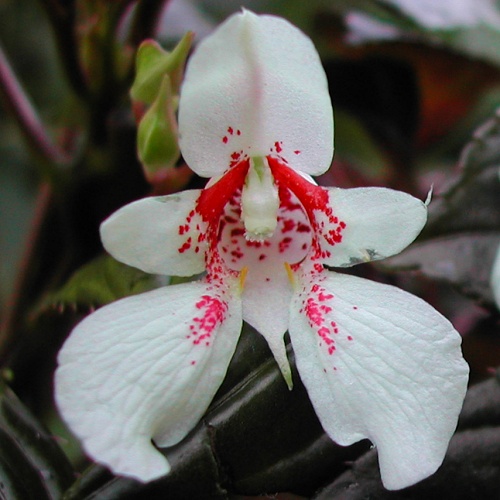| Home |
Strange Wonderful Things
Rare and exotic plants
|
 |
Impatiens campanulata

Germinating the seeds
When to plant -- Plant your seeds when you receive them for best germination.
Getting started -- You may plant each seed in individual, small containers. Or you plant them all in a single
container, but it may be more difficult to transplant them later. Either way, use pots with drainage holes
For soil, use a well draining mix high in organic matter. A typical mix is 2 parts potting soil to 1 part perlite or
coarse sand. An alternate mix is 3 parts perlite to 2 parts coir fiber, with some slow-release fertilizer
mixed in.
Fill the pots with soil and place a seed or 2 on the surface. If you
have
long-fiber sphagnum moss (not ground peat moss), sprinkle some on the
surface. This helps retain moisture around the seeds while allowing light
to reach them, which aids germination.
This photo shows how much moss to use.
If you don't have the moss, sprinkle some of your soil mix around the seeds. Add water until everything is evenly moist (but not soggy).
Until the seeds sprout, ensure that the surface soil always stays moist. A plastic dome or bag
is good for maintaining moisture, but leave it open a crack to allow some fresh air in. You may need to drip a few drops of water over the seeds every day to keep the seeds
moist.
The ideal temperature for germination is between 65 to 75 degrees F (18-24°C). Avoid letting them get above 78° F (25°C). I recommend placing a minimum/maximum thermometer near the pots.
A fluorescent or LED bulb kept 4 inches (10 cm) away provides the right amount of
light. Protect from direct sun.
They should begin germinating in 3 to 5 weeks, but allow up to 8 weeks for any slow ones to sprout.
Increase air ventilation slightly after sprouting to prevent rot, but continue keeping the
soil surface moist for 2-3 weeks after sprouting.
Growing onward...
Lighting -- This Impatiens prefers bright shade, or filtered sunlight. Avoid prolonged direct sun, unless it's early-morning sun.
Fertilizing -- For the first month, it's best to give a very dilute (1/8
strength) liquid fertilizer.
Hydroponic fertilizer
is perfect for young seedlings, since it is easily absorbed and complete.
After the first month, feed about every 2 months with a slow-release (pelleted or organic) fertilizer,
or feed monthly with a liquid fertilizer at half strength.
Transplanting -- When your plants are 2-3 months old, you may gently
transfer them to a larger pot. Water the soil first, and avoid letting the
soil ball break apart, which can damage the roots. After transplanting,
give no sun or liquid fertilizer the first week.
Watering -- Aim to keep the soil moist, but not soggy. Never let it dry
out completely. You may use a moisture meter probe to monitor the moisture levels down in the root zone.
Climate -- Impatiens campanulata comes from the mountains of southern India, where temperatures are mild year-round and nights are cool. I don't know its climate tolerances, but i suspect it might not thrive if temperatures regularly get above 85 degrees F (30 degrees C) and nights are warm. I grow it indoors as a houseplant, where it does great in a small pot or hanging planter. Outdoors,
protect it from freezing temperatures.
Over about 40-45% humidity is best.
Indoors, if the humidity is too low, consider using an ultrasonic room humidifier, which you can buy at
home improvement stores and thrift shops.
It's normal for a leaf to occasionally turn yellow and drop, but if it seems excessive, the soil may be too dry down in the root zone,
or the plant may need more fertilizer.
Pests to watch for -- aphids, scale (dark disks on the stems), mealy bugs.
Start with insecticidal soap spray before using stronger remedies.
Have fun growing them!
- Jeff
Strange Wonderful Things
| Home |
Strange Wonderful Things
Rare and exotic plants |

|
| Entire site Copyright 2003-2025 by Strange Wonderful Things, except as noted |
|


